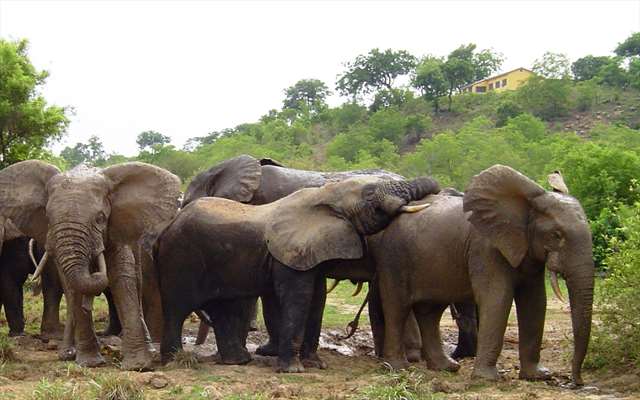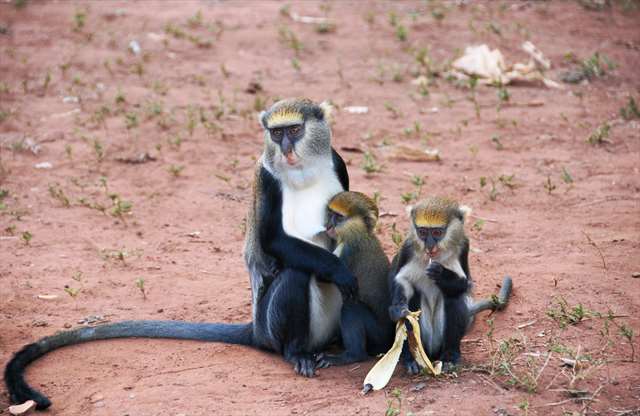Wildlife of Ghana
Ghana wildlife is rich and diverse, with a large number of mammals, reptiles, insects and marine species to be found across the country's varied habitats. Unfortunately there is no one place in Ghana where you can see it all. Furthermore, many of the wildlife locations require long drive times.
Read below about the wildlife of Ghana that you might possibly experience. While wildlife may inhabit various places in Ghana, these maps show where you would most likely be able to encounter these animals.
Elephants

A two-day drive event-filled from Accra, or an hour flight with a 3.5 hour drive, Mole National Park is Ghana's largest, oldest and best game viewing park. While elephants live in some remote places in Ghana, it is only at Mole National Park where you can expect to see elephants in Ghana.
The elephants near the Mole Lodge are accustomed to humans, allowing a close encounter on foot. This is something rare in Africa. Depending on the weather, you can also see duiker, bushbucks, monkeys, warthogs, baboons and other smaller wildlife. Mid-December through mid-April is best because lack of water concentrates the animals at known water sources.
Monkey Sanctuaries

Boabeng-Fiema has a good number of habituated Mona monkeys, and less habituated Black and White Colobus monkeys. The monkeys are revered by the community and therefore they are neither hunted nor killed. The sanctuary has a cemetery where these monkeys are buried with special funerals.
Tafi Atome, located in the Volta Region is a traditional conservation area, home to Mona and Patas monkeys. These monkeys are also quite habituated as they are regarded as gods and are protected by tradition.
Monkeys at any location are best seen in morning or late afternoon. They may be seen at other locations in Ghana, but apart from these two sanctuaries and Mole National Park, they would disappear quickly with your presence.
Birding in Ghana
Ghana has a number of excellent locations for bird watching. This is truly the most abundant form of wildlife to be seen. Over 770 species have been recorded. The options are so great that we have a separate page describing birding locations serious twitchers.
Butterflies
Ghana has an estimated 1,000 species of butterflies - as many species as North America and Europe combined. It is impossible to select specific places because butterflies are found in every forest, but the Bobiri Forest Butterfly Sanctuary is a beautiful reserve with ancient trees that makes this amazing creature a specific attraction. Also of merit are the Owabi Wildlife Sanctuary, the Bunso Eco Park and the Atewa Forest Reserve.
Hippos
Hippos can be seen only at the remote Wechiau Hippo Sanctuary. Correct timing is important, since hippos stay well hidden when water is abundant. Because of this, you will have the best sightings during the dry season (Dec-May).
Located in the far reaches of the Upper West Region you can enjoy a river safari viewing the hippos protected along the Black Volta River. When visiting the Wechiau Hippo Sanctuary, be certain to visit a traditional Sudanese style mud-and-stick mosque, the chief's palace or the local Lobi community.
Crocodiles
There are numerous sacred crocodile ponds scattered throughout Ghana, however the most famous ponds are in the far north at Paga, on the border with Burkina Faso.
Many ponds will have a fetish priest who can provide a blessing and entice a crocodile from the water with incantations and the protests of a live fowl.
At most ponds the crocodile and chicken quickly disappear, but at Paga the crocodiles and much more habituated and will frequently pose for photographs after being satiated.
Some other locations do not require the long travel time:
- Minutes from Kakum National Park at Hans Botel are crocs that pose
- Akatekyi Lagoon, about 30km west of Takoradi
- Egyamba, about 5km west of Princes Town
Baboons
These are fascinating creatures to watch, as they live in large troops and have complex social structures. Without a doubt the two best places in Ghana to see baboons are at Mole National Park and Shai Hills.
Be careful of the baboons though, as they are master thieves and will quickly take unattended items, even from your vehicle.
Antelope, Buffalo, Warthogs
Mole National Park
As with most larger mammals in Ghana, Mole is an excellent place for viewing roan, duiker, Kob, waterbuck and bushbuck antelope, as well as the only place to likely to see warthogs and the African buffalo.Gbele Reserve
In the Upper West region is a rarely visited reserve that is a prime location for our hoofed friends, especially roan antelope.Shai Hills
This small sanctuary is rather close to Accra. It is a good place for morning sightings of baboons and antelope, especially bushbuck. It is also home to a small number of imported zebras and enclosed osteriches.More about Shai Hills
Marine Turtles
Although becoming more rare due to poaching, it is possible to arrange an expedition to search for nesting turtles. Nesting season is from August-March, with October through December are the best months to find nesting turtles. The remote beaches at the far east or the far west are the locations where active turtle conservation projects are protecting the turtles. There is also a serious project ongoing in Prampram.
Bats
Do not worry! Our fruit bats are harmless. The cliffs near Wli Falls have hundreds of bats. There are also bat caves around Ghana, most notable at Shai Hills, near Accra, and Buoyem Caves just outside of Techiman.
The trees in front of 37 Hospital in Accra and in front of the Kumasi zoo are easy locations for viewing bats as well. Especially near dusk, when they depart on their night flights, or in the mornings when they return.

